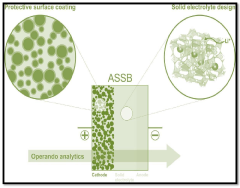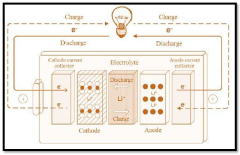Research on solid-state electrolytes for improving the safety and energy density of all-solid-state batteries - Eureka
Solid-State Electrolyte Development Goals
Solid electrolytes have emerged as a promising solution to address the safety concerns and energy limitations of conventional lithium-ion batteries. By replacing the flammable liquid electrolytes with non-flammable solid-state alternatives, solid-state batteries offer enhanced safety and the potential for higher energy densities. However, significant technical challenges remain, such as achieving high ionic conductivity, ensuring chemical and electrochemical stability, and developing scalable manufacturing processes.
Market Demand for All-Solid-State Batteries
- Growing Demand for Safety
All-solid-state batteries offer improved safety compared to conventional lithium-ion batteries, as they eliminate the risk of thermal runaway caused by flammable liquid electrolytes. This addresses a major concern in industries like electric vehicles and consumer electronics, driving demand for safer battery technologies. - Higher Energy Density
Solid-state electrolytes enable the use of lithium metal anodes, which can significantly increase the energy density of batteries. This is crucial for applications that require longer runtime or smaller form factors, such as electric vehicles and portable devices. - Emerging Applications
The improved safety and energy density of all-solid-state batteries open up new application areas, including aerospace, military, and medical devices, where stringent safety and performance requirements exist. - Sustainability and Cost Considerations
As the demand for sustainable energy storage solutions grows, all-solid-state batteries offer potential advantages in terms of recyclability and reduced environmental impact compared to conventional lithium-ion batteries.
Current State and Challenges of Solid-State Electrolytes
- Current Challenges
- Ionic conductivity: Most solid-state electrolytes have lower ionic conductivity compared to liquid electrolytes, hindering battery performance.
- Interface compatibility: Poor interfacial contact between solid electrolytes and electrodes leads to high resistance and capacity loss.
- Mechanical properties: Brittleness and low elasticity of solid electrolytes can cause cracking and degradation during battery cycling.
- Technical Bottlenecks
- Grain boundary resistance: Grain boundaries in polycrystalline solid electrolytes impede ion transport, reducing overall conductivity.
- Electrochemical stability: Many solid electrolytes are unstable against lithium metal anodes, causing interfacial degradation.
- Manufacturing challenges: Producing large-scale, defect-free solid electrolyte membranes with uniform properties is difficult.
- Geographic Distribution
- Research on solid-state electrolytes is globally distributed, with major contributions from the United States, Japan, South Korea, China, and Europe.
- Leading institutions and companies are concentrated in regions with strong battery research and manufacturing capabilities.
Evolution of All-Solid-State Battery Technologies

Existing Solutions for Solid-State Electrolyte Safety
01 Graphene-based all-solid-state batteries
Graphene-based materials enhance conductivity and mechanical properties of battery components, improving energy density and safety.- Graphene-based all-solid-state batteries: Graphene-based materials enhance conductivity and mechanical properties of battery components, improving energy density and safety.
- Lithium sulfide-based positive electrodes: Lithium sulfide-based positive electrodes offer high capacity and stability, achieving high energy density and improved safety.
- Composite solid electrolytes: Composite solid electrolytes enhance ionic conductivity, mechanical strength, and interfacial stability, leading to improved safety and energy density.
- High-capacity positive electrode materials: Novel high-capacity positive electrode materials, like lithium-rich compounds, increase energy density while maintaining safety.
- Semi-solid-state battery designs: Semi-solid-state battery designs combine solid and liquid components, balancing energy density, safety, and performance.
02 Lithium sulfide-based positive electrodes
Lithium sulfide-based positive electrodes offer high capacity and stability, achieving high energy density and improved safety.03 Solid-state electrolyte compositions
Optimized solid-state electrolyte compositions enhance ionic conductivity and stability, improving safety and energy density.04 Manufacturing processes for high-performance batteries
Specialized manufacturing processes assemble battery components and control interfacial properties for improved energy density and safety.05 Battery designs for enhanced safety and energy density
Innovative battery designs address safety concerns and increase energy density through structural modifications, material selections, or safety mechanisms.
Key Players in Solid-State Battery Industry
Samsung SDI Co., Ltd.
TDK Corp.
Core Innovations in Solid-State Electrolytes
- Utilization of solid electrolytes to enable high-energy anodes instead of graphite, reducing the risk of catastrophic failure and fire.
- Development of low melt temperature electrolyte bonded solid-state rechargeable battery electrodes and composite separators with low melt temperature electrolyte components.
- Fabrication methods like co-extrusion, hot pressing, and roll casting for solid-state batteries and battery components.
Potential Breakthroughs in Solid-State Battery Safety
- Solid Polymer Electrolytes
- Inorganic Solid Electrolytes
- Composite Electrolytes








